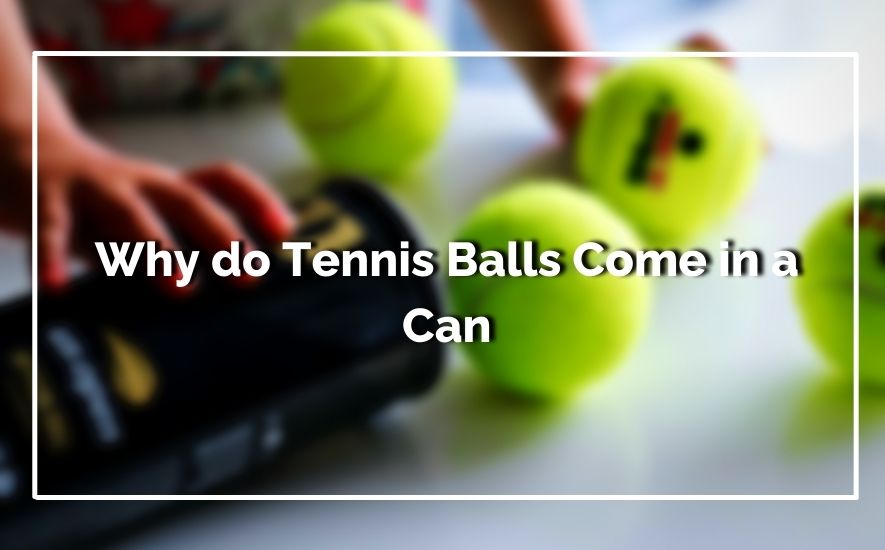Tennis, an exhilarating sport that has captivated the hearts of millions, relies on a fundamental element: the tennis ball. Among the curiosities associated with this small, fuzzy sphere, one question stands out: why do tennis balls come in a can? Delving into the intriguing world of tennis equipment, we uncover the mysteries behind this peculiar packaging choice that has become synonymous with the game.
Why do Tennis Balls Come in a Can? The primary reason tennis balls come in a can is to maintain their pressure and bounce. The pressurized cans prevent air from escaping and keep the balls in pristine condition. The tight seal ensures that the balls remain fresh, responsive, and ready for play.
Over time, players and enthusiasts have often wondered about the rationale behind this packaging preference. Is there a scientific reason, or is it merely a tradition carried over from yesteryears? Understanding the role of the can in preserving the integrity of tennis balls and ensuring a consistent performance on the court offers valuable insights into the dynamics of this global sport.
Table of Contents
Benefits of Packaging Tennis Balls in a Can
Packaging tennis balls in a can offer several advantages that contribute to the overall experience of players and enhance the sport’s appeal.
The can packaging is designed to protect the balls, preserve their quality, and provide convenience to both professional players and recreational enthusiasts. Let’s delve into the various benefits of using can packaging for tennis balls.
1. Freshness and Longevity:
Packaging tennis balls in a can ensure their freshness and longevity. The airtight seal of the can prevents air and moisture from seeping in, preserving the pressure and bounce of the balls. This is especially crucial for professional players who demand consistent performance during intense matches.
Additionally, for recreational players, the extended shelf life allows them to keep using the balls over an extended period, reducing waste and saving money.
2. Easy Portability:
Can packaging offers excellent portability, making it convenient for players to carry tennis balls to the court. The compact size and lightweight nature of the can make it easy to fit in a tennis bag, backpack, or even a pocket. This user-friendly aspect allows players to have ready-to-use balls available at any time without the need for additional storage or cumbersome ball containers.
3. Enhanced Visibility:
The can packaging typically comes in vibrant and eye-catching colors, improving the visibility of the tennis balls during play. This feature is especially valuable in various playing conditions, such as dimly lit indoor courts or during evening matches. The bright colors make it easier for players to spot the balls, enhancing their reaction time and overall gameplay.
4. Protection Against External Elements:
Tennis balls are susceptible to damage from dust, dirt, and other external elements, which can affect their performance. Packaging tennis balls in a can act as a protective barrier, shielding them from potential harm and maintaining their integrity. Whether stored in a sports bag or left in the trunk of a car, the can ensures the balls remain in optimal condition until they are ready to be used.
5. Environmentally Friendly Design:
In recent years, there has been a growing concern for environmental sustainability, and tennis ball packaging aligns with this ethos. Made from recyclable materials, these cans contribute to reducing plastic waste and minimizing the environmental impact. Players can responsibly dispose of the used cans in recycling bins, supporting eco-friendly practices in the sport.
History and Evolution of Tennis Ball Packaging
Tennis, a sport with ancient origins, has seen its fair share of transformations over the years, not only in terms of gameplay but also in the way its essential equipment, like tennis balls, is packaged.
The evolution of tennis ball packaging can be traced through different eras, reflecting changes in manufacturing techniques, materials, and consumer preferences.
1. Origins and Early Packaging Techniques
In the early days of tennis, dating back to the 12th century, tennis balls were made from various materials like leather, wool, and even human hair. These balls were typically hand-stitched, resulting in irregular shapes and sizes.
As the sport gained popularity in the 19th century, manufacturers started experimenting with different packaging materials, mainly employing wooden boxes to store and transport the tennis balls. These wooden containers were often plain and simple, offering minimal protection to the balls inside.
2. The Advent of Pressurized Cans
The real breakthrough in tennis ball packaging came with the introduction of pressurized cans in the mid-20th century. This innovation revolutionized the industry, as it allowed tennis balls to be packed in airtight containers, preserving their bounce and performance for a longer time.
Pressurized cans also offered convenience to players, allowing them to open a new can of fresh balls whenever they desired, maintaining consistent playability throughout matches or practice sessions.
3. Plastic and Environmentally-Friendly Packaging
As environmental awareness grew in the late 20th and early 21st centuries, tennis ball packaging evolved to become more sustainable. Manufacturers shifted away from using excessive packaging materials, adopting plastic canisters that were not only lightweight but also recyclable.
Additionally, some companies explored more eco-friendly options, such as biodegradable packaging materials, demonstrating their commitment to reducing the sport’s environmental footprint.
4. Customization and Branding
With the rise of professional tennis and the prominence of tennis tournaments, the packaging of tennis balls took a new turn toward branding and customization. Tennis ball cans began to feature eye-catching designs and logos of major tournaments, making them appealing to fans and collectors alike.
This move not only boosted the sport’s popularity but also turned tennis ball packaging into a marketing tool for manufacturers and sponsors, enhancing their brand visibility.
5. Innovative Storage Solutions
In recent years, tennis ball packaging has seen a surge in innovative storage solutions. From resealable bags to vacuum-sealed pouches, manufacturers are constantly experimenting with new ways to keep tennis balls fresh and playable for extended periods.
These advanced packaging designs aim to cater to both professional players and recreational enthusiasts, ensuring that every player gets the best possible experience on the court.
Why Do Tennis Balls Come in a Can? Exploring the Purpose Behind the Packaging
Ever wondered why tennis balls always arrive in a can? It’s not just about tradition; there’s a purpose behind the packaging. The sealed can isn’t just a container; it’s a protective chamber. Tennis balls are pressurized, and they can maintain this pressure, preserving their bounce and performance. The airtight seal prevents dust and moisture from affecting the felt, ensuring each ball is game-ready. So, the next time you pop open a can of tennis balls, remember it’s not just about style; it’s about maintaining the integrity of the game, one can at a time.
Different Types of Tennis Ball Packaging
Tennis ball packaging plays a significant role in ensuring the integrity, preservation, and accessibility of these essential sports equipment. Different types of packaging cater to varying preferences and requirements of tennis enthusiasts. Let’s explore the various tennis ball packaging options available in the market today.
Can Packaging:
Can packaging is one of the most traditional and widely used methods for tennis ball storage? Tennis balls are sealed in a pressurized metal can that prevents air from entering, keeping the balls fresh and bouncy.
This packaging type is preferred by professional players and tournament organizers as it maintains the ball’s optimal performance. Additionally, the transparent plastic lid allows players to inspect the condition of the balls before purchase.
Mesh Bag Packaging:
Mesh bag packaging offers an eco-friendly and lightweight alternative to conventional can packaging. Tennis balls are packed in a breathable mesh bag, reducing the need for excessive plastic materials. The mesh construction allows air circulation, preventing the balls from becoming flat or damp.
Moreover, the bag’s resealable feature allows players to store unused balls securely, making it ideal for recreational players and tennis clubs.
Vacuum-Sealed Packaging:
Vacuum-sealed packaging is designed to prolong the shelf life of tennis balls by removing excess air and sealing them in airtight plastic bags. This method ensures that the balls retain their pressure and bounce, even during extended periods of storage. Vacuum-sealed packaging is particularly useful for bulk purchases, ensuring that each ball maintains its quality until it is ready for use.
Ball Hopper Packaging:
Ball hopper packaging is a unique and convenient option for storing tennis balls. Tennis balls are placed inside a durable plastic hopper with a handle for easy carrying and dispensing. This packaging is ideal for coaches, instructors, and players looking for a quick and efficient way to collect balls during practice sessions. The hoppers come in various sizes, accommodating different ball capacities based on the user’s needs.
Customizable Packaging:
Customizable packaging is a modern approach that allows players to personalize their tennis ball containers. Brands offer options for players to add their names, logos, or unique designs to the packaging, making it a great choice for gifts or promotional purposes. Furthermore, customizable packaging enhances brand loyalty and appeals to players who value personalization and aesthetics.
Preserving Tennis Ball Quality: Can vs. Other Packaging
When it comes to preserving the quality of tennis balls, the choice of packaging plays a crucial role. Tennis balls are vital equipment in the game, and their performance directly impacts the players’ experience. In this comprehensive note, we will explore the key differences between preserving tennis ball quality using cans and alternative packaging options.
1. Can Packaging: A Classic Choice
Can packaging be the traditional and widely used method for preserving tennis ball quality? The hermetically sealed metal can is designed to protect the balls from external elements like moisture and air, preventing them from losing their pressure and bounce. The airtight seal ensures that the tennis balls maintain their factory-fresh feel and last longer on the court.
Additionally, the sturdy nature of the can safeguard the balls from any potential physical damage during transport and storage, making them a reliable option for players and professionals alike.
2. Plastic Bag Packaging: A Convenient Alternative
Plastic bags have emerged as a popular alternative to canned packaging due to their cost-effectiveness and ease of use. These bags typically come with a resealable feature, allowing players to access and reseal the balls as needed.
However, while plastic bags can keep tennis balls together and protect them from minor exposure, they fall short of maintaining the balls’ pressure and bounce over extended periods. Without an airtight seal, air permeation can affect the ball’s integrity, reducing its performance on the court and possibly requiring replacement more frequently.
3. Environmentally-Friendly Options
As environmental concerns gain prominence, many tennis ball manufacturers have explored eco-friendly packaging options. Cardboard tubes and paper-based packaging have emerged as environmentally-conscious alternatives to cans and plastic bags.
These materials are biodegradable and sustainable, aligning with the increasing demand for eco-friendly practices in the sports industry. While these packaging options may not provide the same level of protection as cans, they strike a balance between performance and environmental impact.
4. Vacuum-Sealed Packaging: Optimal for Longevity
In recent years, vacuum-sealed packaging has gained traction as a premium option for preserving tennis ball quality. The vacuum-sealed packs effectively remove air and moisture, ensuring that the balls retain their original pressure, bounce, and durability for an extended period. This packaging method excels in maintaining the freshness of tennis balls, making it a preferred choice for professional players and tournaments. However, the drawback is that vacuum-sealed packs tend to be more expensive than traditional can or bag packaging, making them less accessible for casual players.
5. Hydration Method for Ball Revival
Regardless of the chosen packaging, tennis balls might lose their bounce and pressure over time, especially if stored for an extended period. A popular technique to revive tennis balls is the hydration method.
By placing the balls in a container with a damp cloth or a small amount of water and sealing it overnight, the balls can regain some of their bounce. This method is effective for both can-packaged and alternative-packaged tennis balls, making it a useful tip to extend the life of your tennis equipment.
Conclusion
In conclusion, the reason behind tennis balls being packaged in cans is a unique combination of preserving their performance and ensuring a memorable tennis experience for players worldwide.
The pressurized cans safeguard the balls’ bounce and texture, retaining their peak condition until opened. Moreover, the portability and compactness of cans allow for convenient storage and transport, making them ideal for players on the go.
The choice to package tennis balls in cans reflects a thoughtful consideration of players’ needs and aspirations, fostering a sense of excitement and anticipation each time the can is cracked open. Thus, this packaging tradition continues to serve both practicality and a touch of tradition in the dynamic world of tennis.
What material are tennis ball cans made of?
Tennis ball cans are typically made of metal, usually steel or aluminum. The metal helps protect the balls inside from damage during shipping and storage. Metal cans are strong and durable, and provide a tight seal to keep the balls pressurized.
Why are pressurized cans needed for tennis balls?
Tennis balls are filled with air under pressure to help them bounce properly on the court. Pressurized cans help maintain this internal air pressure so the balls stay bouncy and don’t go flat before use. The internal pressure gives the balls their familiar fuzzy, felt-like coating too. Without pressurized cans, balls would lose their bounce and soft texture.
How does the pressurized can help the balls last longer?
The pressurized environment inside the can slows down the natural escaping of air from inside the balls over time. This helps prolong the shelf life of the balls before play. Pressurized cans keep the balls in a consistent, inflated state until you open the can to use them. This allows them to maintain good bounce performance longer.
Why are some tennis ball cans re-sealable?
Some tennis ball cans have a re-sealable lid so any unused balls can be protected and pressurized again after opening. This allows you to take out a few balls at a time while keeping the rest at optimal inflation. The re-sealable lid makes sure no balls get damaged or lose pressure while stored inside between uses.
Are pressurized cans used for any other sports balls?
Yes, other ball sports like racquetball, squash, and handball use pressurized cans too. The cans help maintain the correct internal pressure and bounce of these balls for good play on the court. Pressurized packaging is important for any hollow sports ball that needs inflation and consistent bounce properties.



